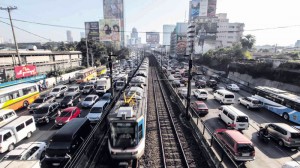
A UN official has described Manila as “a big challenge” when it comes to handling natural disasters, because of the “scale and multitude of risks facing it.” LEO M. SABANGAN II
BANGKOK—A UN official has described Manila as “a big challenge” when it comes to handling natural disasters, because of the “scale and multitude of risks facing it.”
“Actually, any big city like Manila is a challenge,” said Margareta Wahlström, who heads the UN Office for Disaster Risk Reduction (DRR).
Interviewed during the just-concluded 6th Asian Ministerial Conference on Disaster Risk Reduction, or AMCDRR, in the Thai capital, Wahlstrom said Manila as a local government unit (LGU) was “a tough issue… because of very important responsibilities delegated to it by the national government.”
While the national government had “the right DRR-related policies,” the UN official said that “some LGUs do not have enough technical capability to implement these policies.”
Strengthening these LGUs would put the Philippines “in a very good space,” said Wahlström, who serves as UN Secretary General Ban Ki-Moon’s special representative for disaster risk reduction.
Manila could also adopt “some best practices by model local governments like Albay and Cebu,” Wahlstrom said, adding that the city government and other Philippine LGUs should “enhance disaster resilience programs at the local level” by strengthening the role of women, children, the youth and persons with disabilities in disaster risk reduction planning and management.
LGUs could also “increase public investments on DRR and promote the use of science and technology in disaster risk reduction programs.”
In a report, the Geneva-based UN International Strategy for Disaster Risk Reduction (UNISDR) cited Makati City, Albay province, as well as San Francisco town on Camotes Island in Cebu for their “best practices” on a wide range of DRR-related challenges, including early warning, legislation and food management.
Makati made it to the list for its “sophisticated and efficient disaster risk management system,” which has fully institutionalized disaster risk reduction, preparedness and emergency management (into) dedicated organizations, (with) direct funding at the local level.
Disaster risk reduction in Makati has been “integrated into urban planning, health, disaster response and risk governance at different government levels,” according to the report.
It added that Makati also “engages all levels of society, particularly barangays (villages), which conduct regular community dialogues to discuss risk management issues.”
Albay’s disaster risk reduction strategy “centers on relocating businesses and more than 10,000 households.”